

Worldwide Insights
TGM Global
E-Commerce Survey
Need help understanding your E-commerce customers? Our Global E-commerce survey can help. Get actionable insights into what motivates online shoppers and how to better meet their needs. Find out your customers' statistics and insights below!


TGM Global E-Commerce Shopping Behavior Survey
KEY FINDINGS
of surveyed people in worldwide shop online using their SMARTPHONE
of global shoppers surveyed purchase CLOTHES and ACCESSORIES when shopping online
would prefer GIFT CARD OFFERS over any other types of promotion
of online shoppers in worldwide find LOW PRICES and FREE SHIPPING to be the most valuable factor

TGM Global E-Commerce Survey Overview
There is no denying that the digital and e-commerce sectors witnessed explosive growth in recent years, especially when lockdowns became the new normal and both businesses and consumers were forced to go online.
The focus in 2023 will be on excelling in an increasingly competitive market by meeting and even exceeding your customers’ expectations. For that reason, TGM Research has conducted an independent international survey across 33 countries to get a better understanding of how this worldwide e-commerce phenomenon has shifted consumer behavior, and gathered valuable insights.
Are you curious to know more? Download the report!


Stay up-to-date with our Worldwide E-Commerce Insights Report 2022
TGM Global E-Commerce Survey
Find it Interesting? Download the TGM International E-commerce Customers Insights Report for free right away.
E-Commerce Shoppers Insights Data
Selected Insights from the survey:
The survey results are in, and we've gathered some
insights that we thought you might find interesting!

-
E-COMMERCE SURVEY STANDPOINT
-
ONLINE SHOPPING FREQUENCY
-
POPULAR DEVICE
-
MOST-PURCHASED PRODUCTS
-
ATTITUDE TOWARDS ONLINE SHOPPING
-
ONLINE PAYMENT
-
TOP E-COMMERCE PLATFORMS
-
What makes online shopping different in 2022?In 2022, online shopping was more accessible than ever before. In fact, 73% of respondents globally said they have done at least one online purchase every month during the last 12 months. This flexibility benefits all kinds of users and encourages more consumers to do their online shopping via smartphones (75%).
The industry that appears to primary beneficiary of E-commerce is fashion and apparel. In all surveyed countries, clothing and accessories are the most often purchased goods across all age groups (62%). Food also became a popular category in e-commerce, although it has traditionally been more challenging for e-commerce companies to break into compared to other categories such as fashion and electronics. This is because food is a perishable product that requires special handling and transportation. However, online grocery delivery and pickup services, as well as meal kit delivery services, have become more popular in many markets during the pandemic as people look for ways to get groceries and meals while minimizing exposure to the virus.
Smart shopping pattern tends to be more common. Consumers nowadays are motivated by direct savings more than ever, they don’t want to miss out on any chance to save money. They prefer to get a direct price discount than get free shipping or additional gifts. Also, when shopping online consumers prefer to pay for their online shopping with credit cards (27%) to get more advantages such as points, cashback, or additional buyer protection.
There are many strong brands in e-commerce, and their success can be attributed to various factors such as the quality and uniqueness of their products, their reputation and brand recognition, the effectiveness of their marketing and advertising efforts, and the overall customer experience they provide. Some examples of well-known and successful e-commerce brands include Amazon, which is one of the largest and most successful e-commerce companies in the world; in our, study Amazon is considered the strongest eCommerce brand worldwide.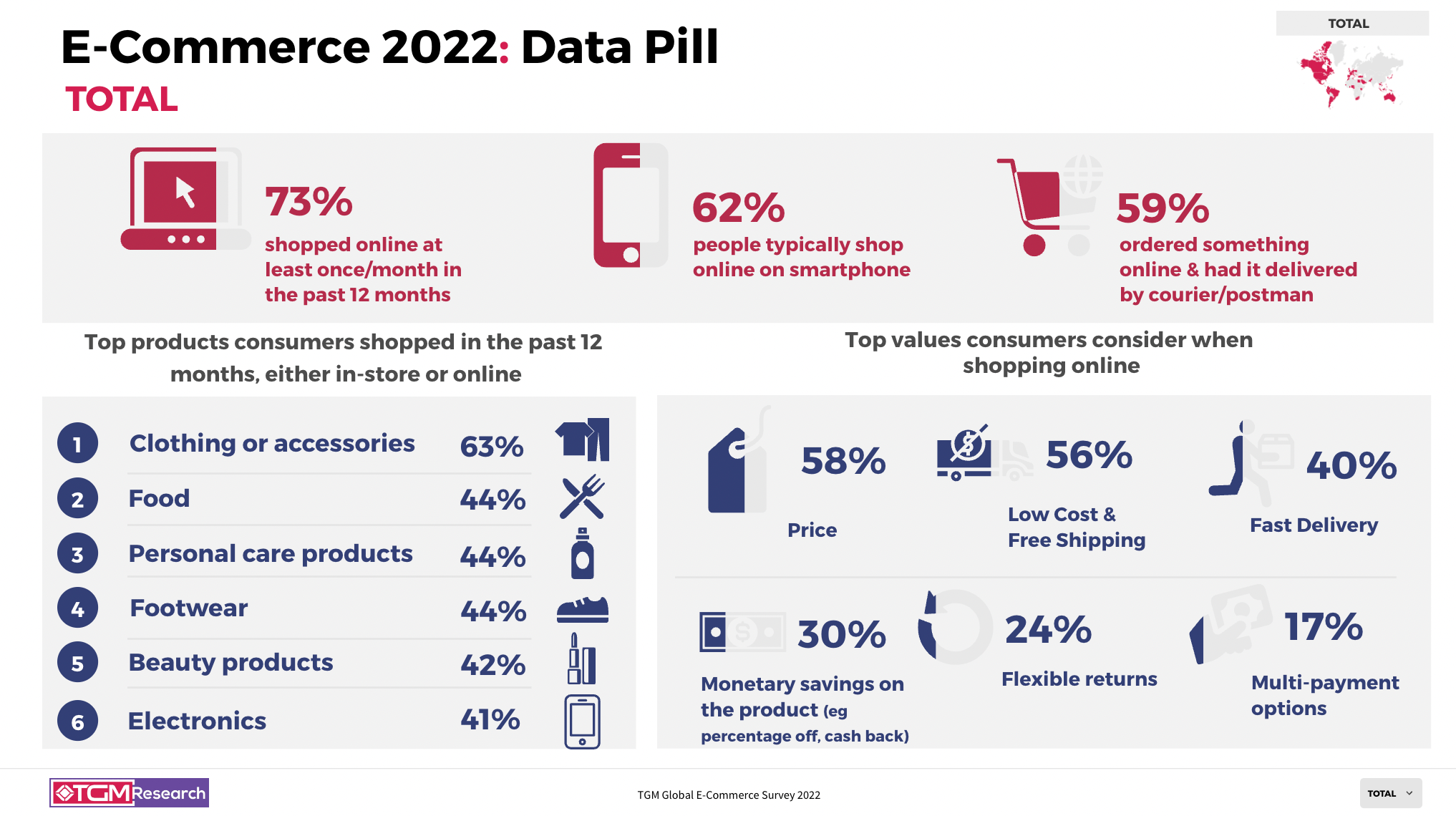
-
How often do people shop online in the past 12 months?In the past, customers had to visit brick-and-mortar stores to satisfy their shopping needs. This process took time, and it sometimes entailed time-consuming travel. The emergence of e-Commerce has significantly increased the convenience of shopping and transformed the way how people make purchases. The overall frequency of online purchases has been increasing in recent years as more and more people have become comfortable with shopping online and as the availability and convenience of online shopping options have increased. In our Global E-commerce study, 73% of respondents said they have done at least one online purchase every month for the past 12 months.
Particularly, people from all age groups and genders shopped online 2-3 times per month. 18% of people in the 25-to-34 age group made an online purchase every week, whereas most people in the 55-to-64 age group only did that once per month (23%).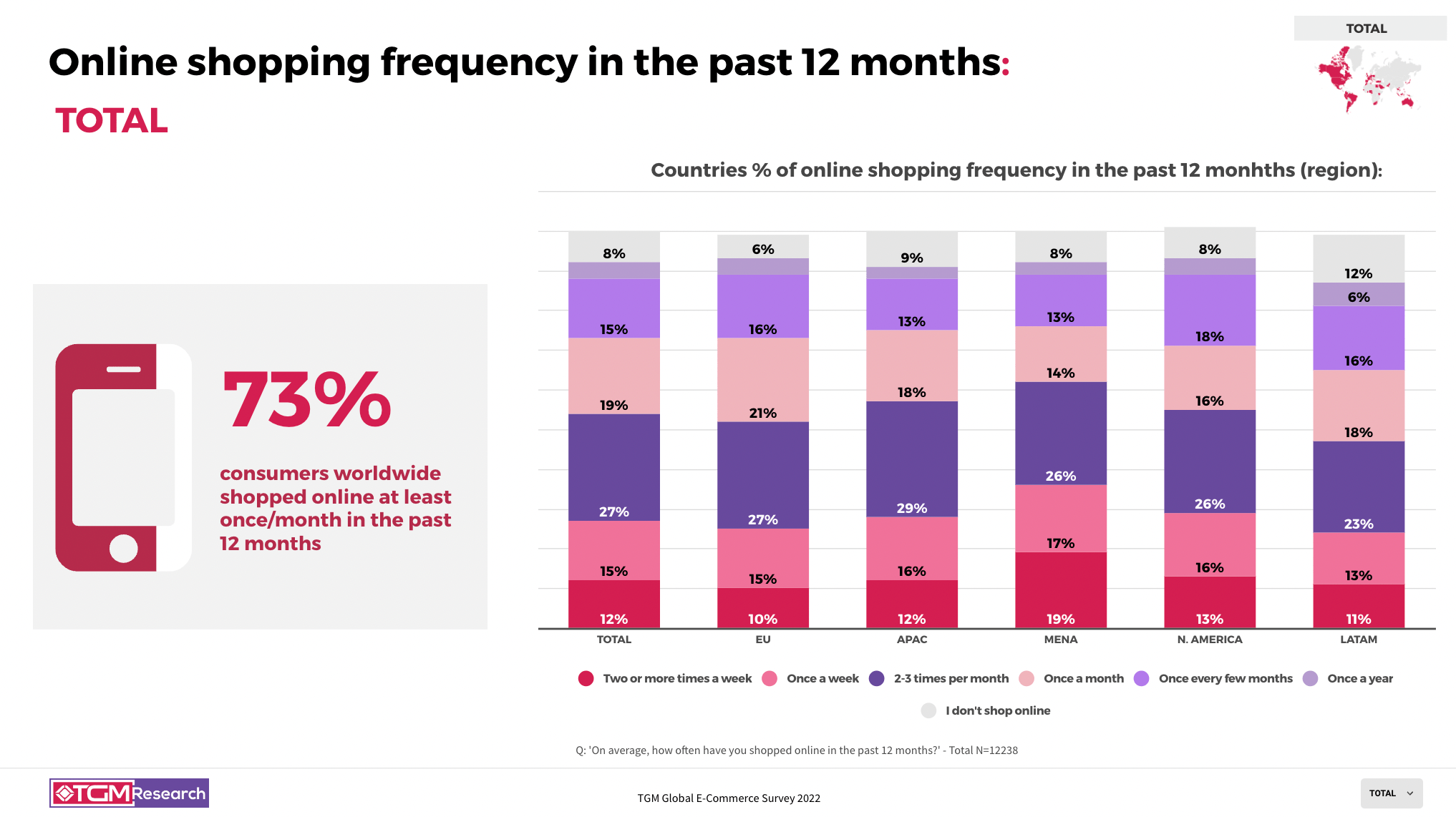
-
How do people typically shop online?While physical stores are restricted to their surrounding vicinity, e-commerce businesses know no boundaries. All one needs is a gadget with an Internet connection to shop wherever and whenever they want.
The most popular device for making online purchases tends to vary depending on the specific market and the preferences of the segment \ individual consumer. However, smartphones are generally the most popular devices for making online purchases. In total, 75% of Internet purchases are made via phones, making them the most popular tool of choice.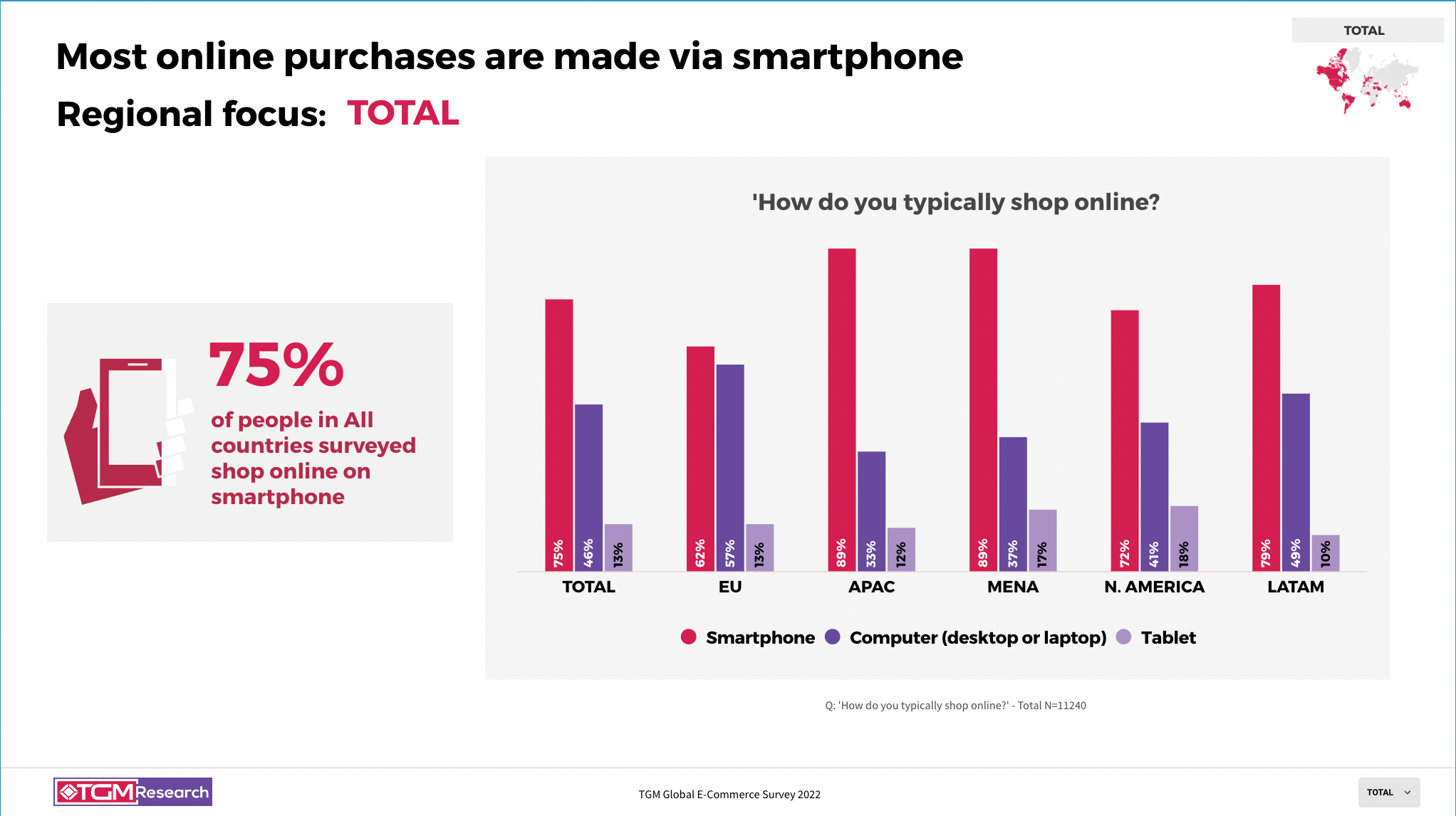
-
Which products have people shopped for in the past 12 months, either in-store or online?E-commerce has transformed the way that people shop in a number of ways. By comparing features, costs, and benefits, customers may use the internet to investigate items and decide whether they are actually worth the investment. E-commerce has also made shopping more convenient by allowing people to shop from anywhere with an internet connection and at any time, rather than being limited to traditional store hours.
The industry that appears to benefit the most from the growth of the E-commerce channel is fashion and apparel. In all surveyed countries, clothing and accessories are the most-purchased goods across all age groups. It is not only the female domain, both men and women claimed to make online purchases in this category most. For other categories, gender preferences reflect the overall shopping patterns for categories. The percentage of respondents who purchased electronics online was significantly higher for males (51%) than for women (29%). Meanwhile, women purchased more beauty and personal care products online, accounting for 54% and 51%, respectively.
What is noticeable, is the frequency of food and grocery: 40% of respondents worldwide claimed that they tend to make their food purchases online. While this category has traditionally been more challenging for e-commerce companies to crack, the COVID-19 pandemic has led to a significant increase in online food and grocery shopping, and it is likely to continue to be a popular category in e-commerce.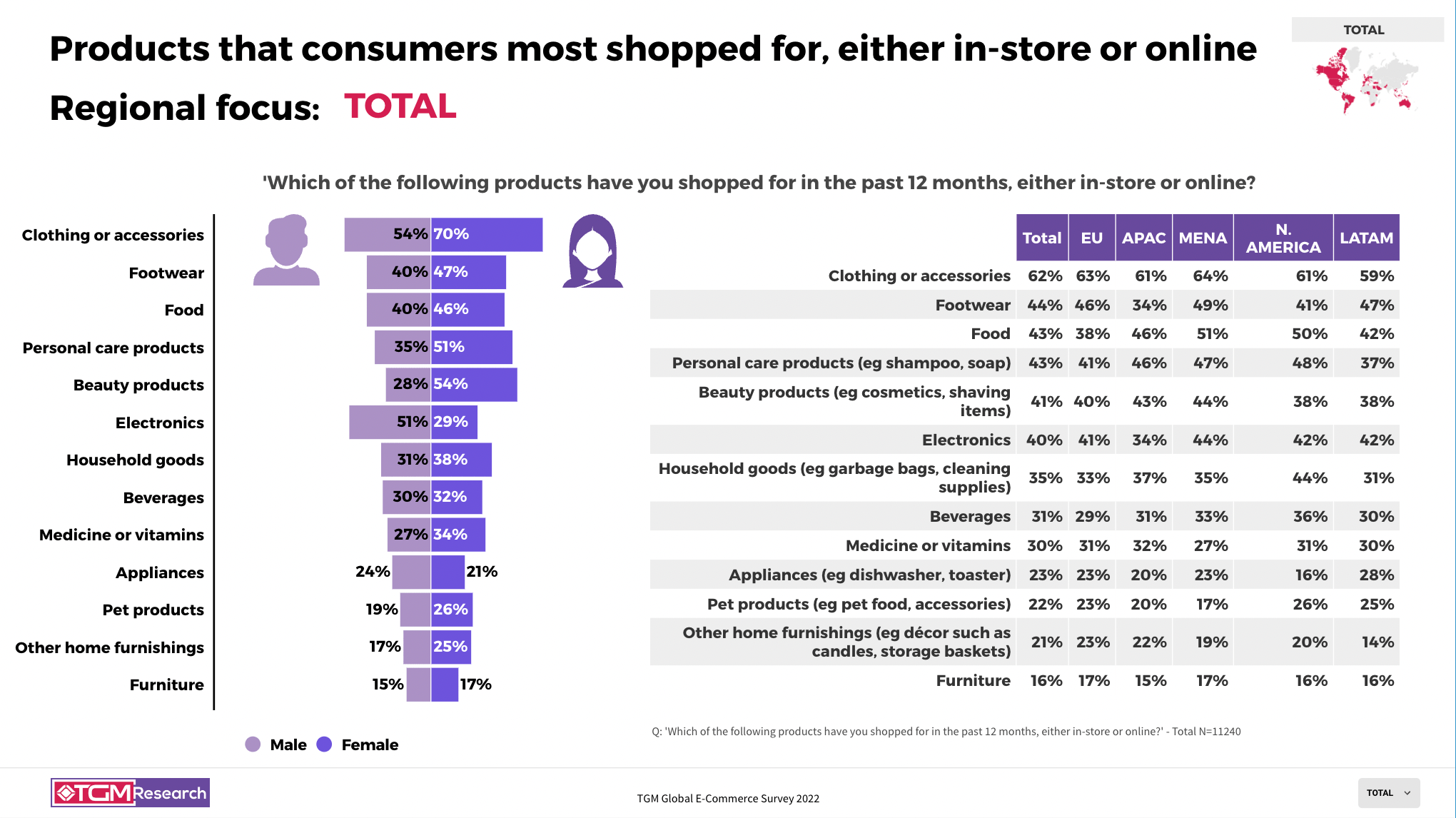
-
What values do consumers look for?Smart shopping used to be particularly popular among price-sensitive consumers who were looking for the best deals and want to make sure they are getting the most value for their money. Nowadays this pattern became more common. Searching for bargains \ best deals became popular amongst multiple consumer segments - 49% of surveyed people worldwide claim that % off discounts are the most appealing type of promotion when shopping online or offline. This is why big sales during the year are considered the right time for ‘appropriate spending’.
Along with financial promotions, non-financial benefits such as free shipping are also quite popular in APAC (36%), the N. America (39%) and LATAM (36%) regions prefer gift with purchase.
This also proves that price is the most important factor that determines where and when they shop. Based on our global study, 58% of those who were surveyed believe ‘price’ is the most critical element when shopping online, followed by the free shipping at 57%.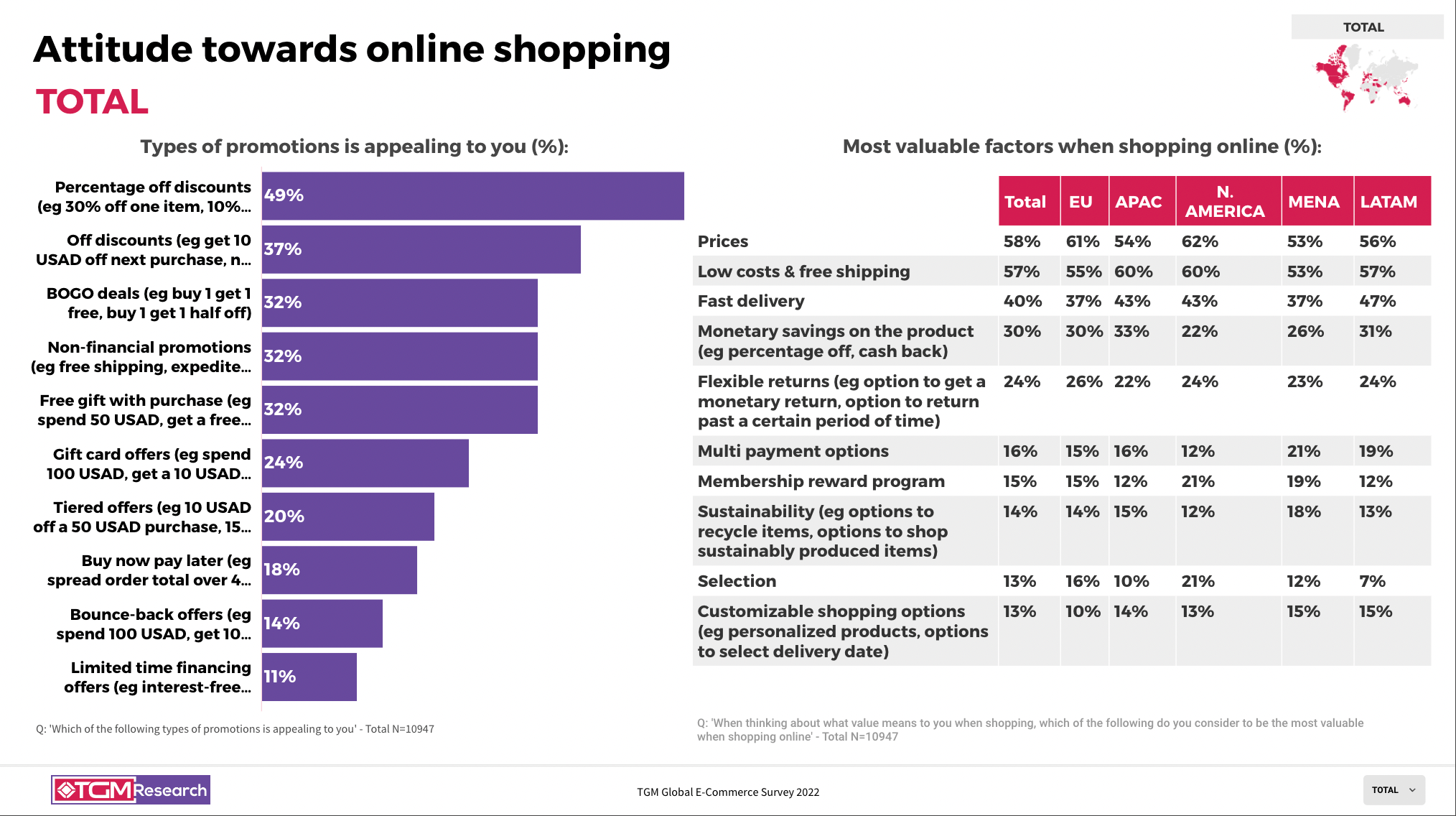
-
What are consumers' preferred online payment options?The most popular methods of payment in e-commerce vary depending on the specific market and the preferences of the particular consumer segment. It also differs regionally - however, it is not a surprise that many consumers prefer to pay for their online shopping with credit card (27%). In certain situations, credit cards can present more advantages such as points, cash back, or layer of buyer protection compared to other payment options.
Different regions have different preferences for online payment methods. For most (except APAC), credit card is the preferred mode of payment when shopping online with the highest percentage in N. America at 41%.
While non-cash payments are on the rise, there are certain regions in the world (specifically APAC (28%) and MENA (22%) that still prefer to use cash payments (COD - 'cash-on-delivery'). This is common in developing countries and mostly due to cultural preferences than avalaibility of other methods.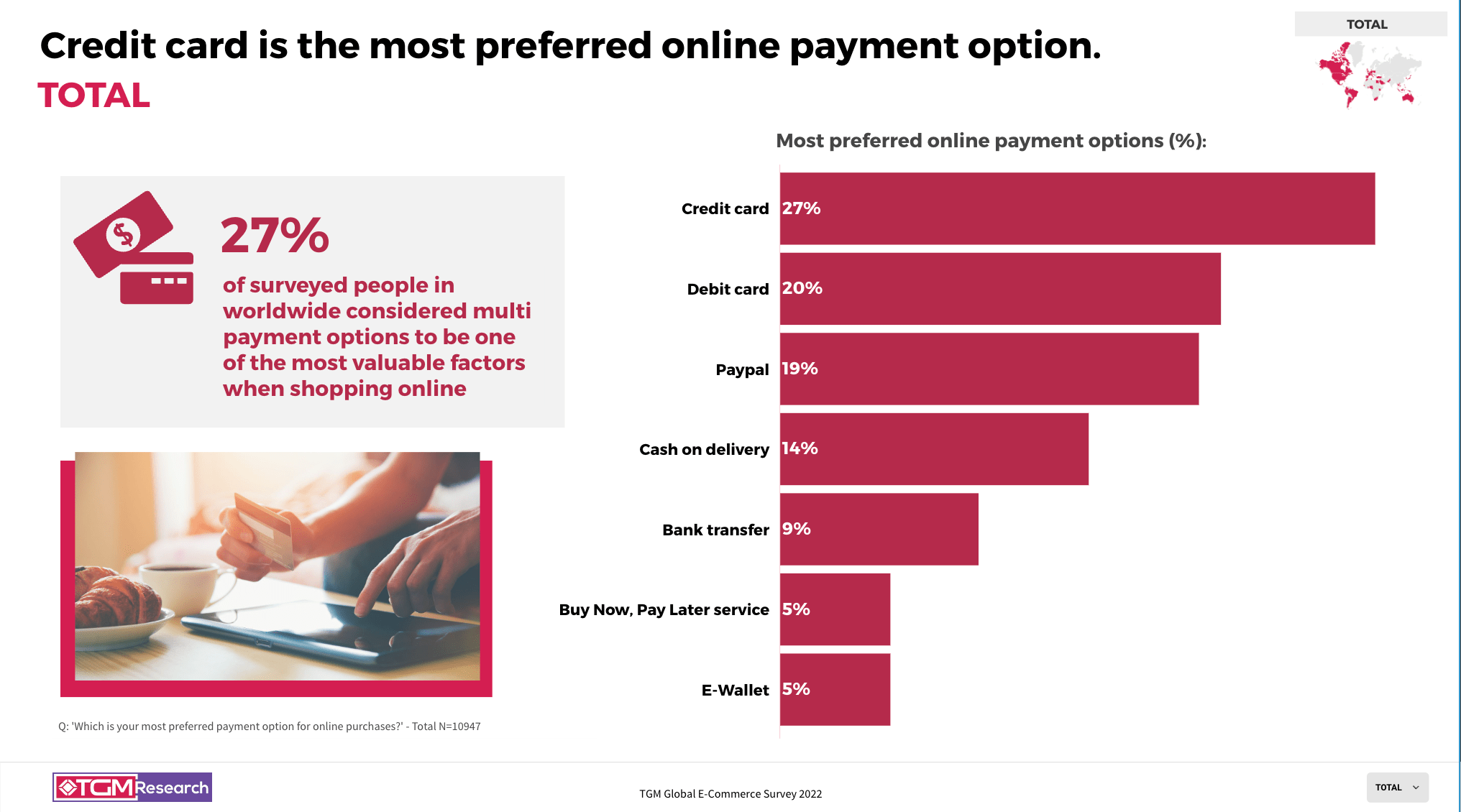
-
Which online shopping platforms are the most known?E-commerce has also led to the development of new business models and has led to the raise of many successful brands. The COVID-19 pandemic has had a significant impact on the e-commerce industry, and many e-commerce brands have seen significant growth as a result.
However, businesses have been constantly attempting to stay relevant since the pandemic settled.
Online stores, particularly e-commerce sites, were the most popular shopping channel throughout the pandemic. Amazon (40%) is regarded by many as the most notable brand for shopping online and also the most famous when compared to other brands followed by Shopee, eBay, and Mercado Libre.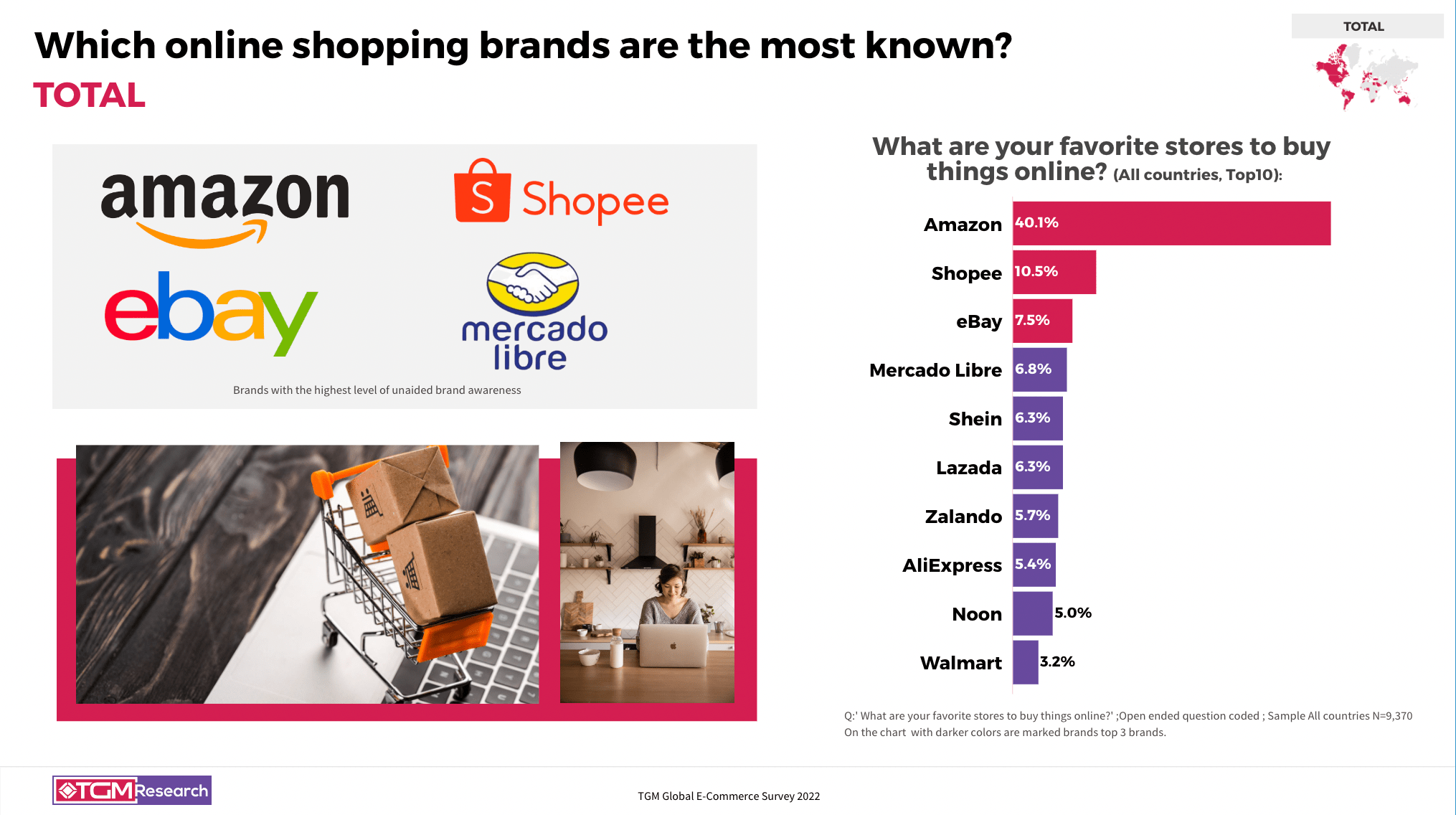
What is the incidence of online shopping in the globe?
According to the results of the TGM E-commerce Survey in worldwide in November 2022 - 46% shopped online at least once/month in the past 12 months
How often do people worldwide shopping via online platforms?
Based on the results of the TGM E-commerce Customers Survey in worldwide, the frequency of online shopping was:
- 28% shop online once or a few times a week,
- 27% do online purchase 2-3 times per month,
- 12% shop through online platforms once a year or less
What are consumers' preferred online payment options for online purchases?
The payment method chosen to use online is more important than it seems. According to TGM's international survey results, 27% of shoppers in worldwide do online purchases primarily by credit card. Meanwhile, 14% preferred to pay cash on delivery.
What is the strongest online shopping platform brand worldwide?
According to the TGM E-commerce Survey in worldwide, respondents pointed at Amazon as the online shopping platform that comes to mind first when buying things online.
Data on different segments of audiences
Data comparing E-commerce audiences across regions is available to understand better how E-commerce customers engage with and interact with shopping activities.
Worldwide E-commerce survey
Results of the world’s largest independent survey about E-Commerce shopping behavior, over 12.200+ people from 33 countries were polled regarding their shopping habits and frequency.
Popular online shopping brands and promotions
By studying the most popular online shopping brands and promotion preferences, you learn more about what resonates with and appeals to specific target audiences.
Customizable and downloadable report
Extensive data appendices to support our research's findings and insights, TGM Global E-Commerce Report, which is customized and can be downloaded, explain behaviors and gives detailed information.
METHODOLOGY:
SAMPLE:
Age groupings by 18-24 (15,4%), 25-34 (24,3%) 35-44 (24,3%), 45-54 (20,8%), 55-64 (15,3%).
Country sample size: Argentina N=312, Australia N=328, Belgium N=339, Brazil N=397, Canada N=426, Colombia N=395, Costa Rica N=260, Croatia N=370, Denmark N=242, France N=442, Germany N=432, Indonesia N=394, Italy N=444, Japan N=582, Mexico N=397, Netherlands N=317, Pakistan N=246, Philippines N=354, South Korea N=303, Spain N=460, Switzerland N=216, Thailand N=343, Tunisia N=249, Turkey N=447, UAE N=413, UK N=483, US N=458, Vietnam N=313, Wales N=212.
Results were weighted to take country population structure aged between 18-55 or 18-64 (depending on country profile demographics structure) into account.
ABOUT TGM:
E-COMMERCE CUSTOMERS RESEARCH BY COUNTRY
-
TGM E-Commerce Market Research Insights | Data in Europe
-
TGM E-commerce survey report in MENA | Download Insights report
-
TGM E-commerce Market research Survey 2022 | Data in Asia Pacific
TGM E-commerce Market research Survey 2022 | Data in Asia Pacific
-
TGM E-commerce Market research Survey 2022 | Data in LATAM
TGM E-commerce Market research Survey 2022 | Data in LATAM
-
TGM E-commerce Customer Insights in North America | Download report
Interested in market research projects in the world?
Learn more about our online survey panel worldwide